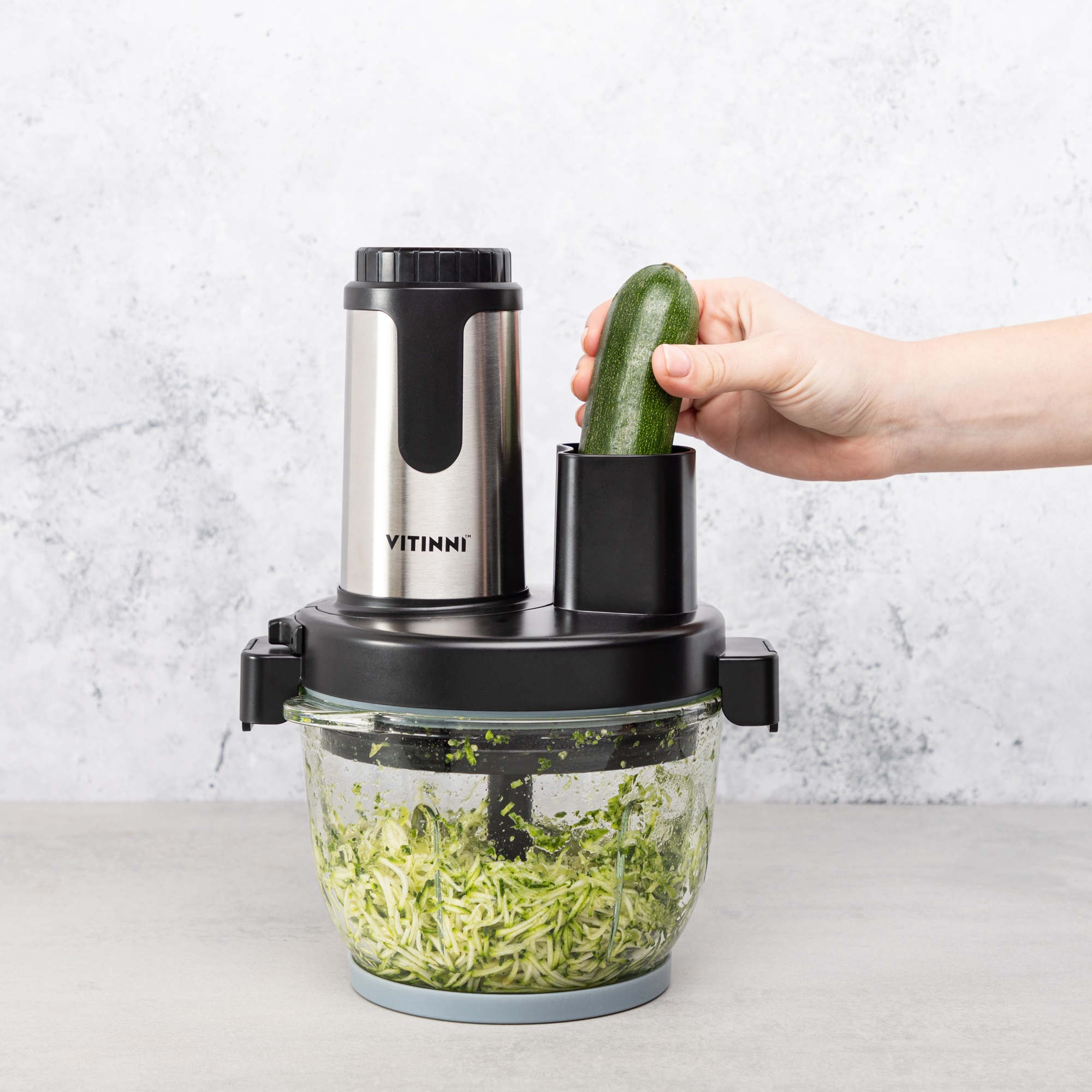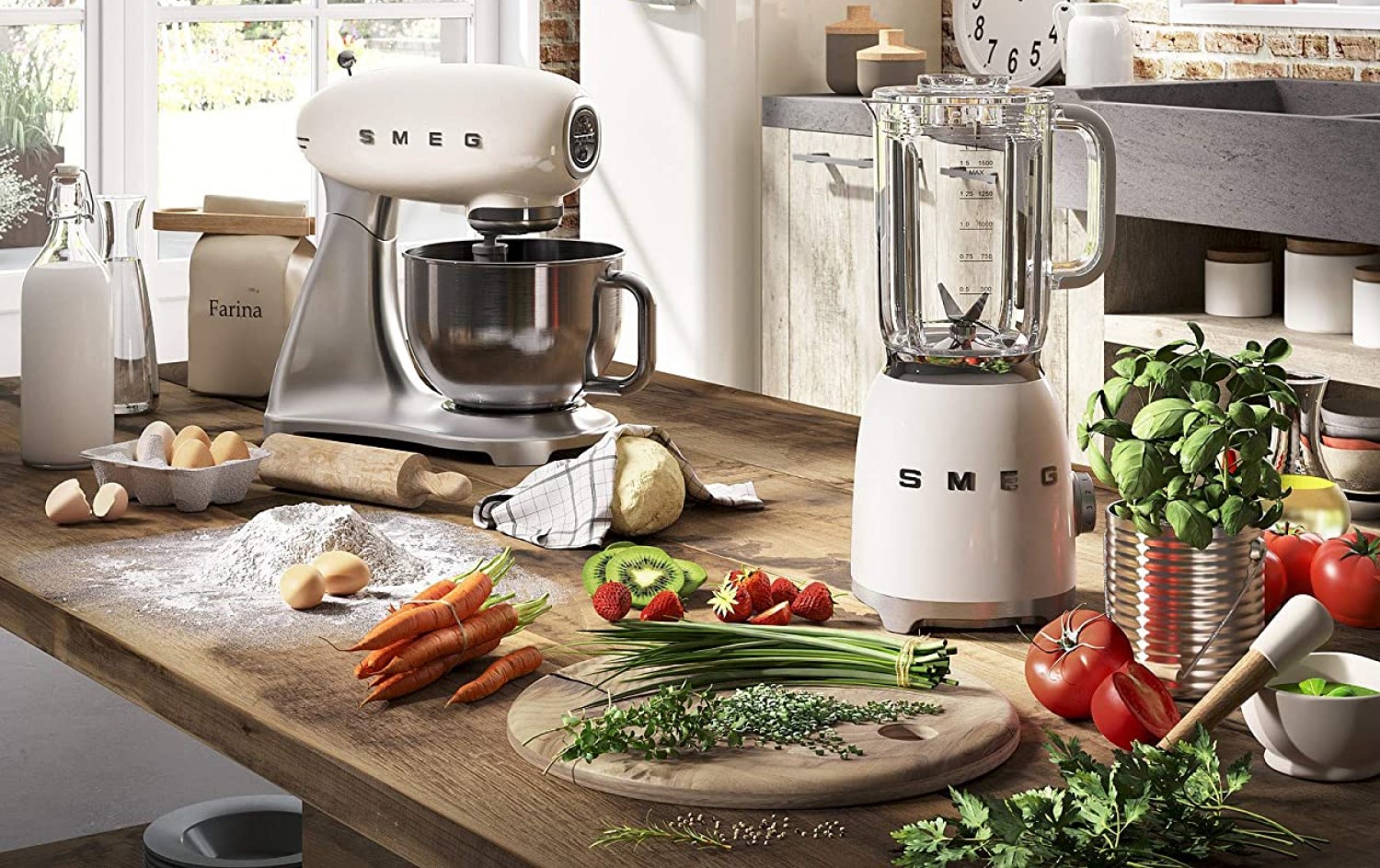I. Introduction
A food processor is a countertop appliance that utilizes sharp blades or discs to chop, shred, slice, puree, and mix ingredients. It’s a game-changer in the kitchen, saving you time and effort compared to manual chopping and mixing.
II. Parts of a Food Processor (Let’s Get Familiar)
Base: This sturdy unit houses the motor and provides stability.
Work Bowl: This is the container where you place your ingredients. It comes in various sizes, so choose one that suits your needs.
Lid: This secures the work bowl and features a feed chute for adding ingredients. Some lids have safety interlocks that prevent the motor from running unless properly locked.
Blade: The most common blade is the S-blade, ideal for chopping, mincing, and pureeing. Other blades may be available for specific tasks like dough kneading.
Disc: These interchangeable discs come in various shapes and sizes for slicing, shredding, and grating.
Feed Chute: This opening in the lid allows you to add ingredients safely while the processor is running.
Motor: This is the powerhouse that drives the blades and discs. Different models offer varying motor power, impacting processing speed and capacity.
Buttons and Controls: These buttons allow you to turn the processor on and off, adjust speed settings (low, high, pulse), and sometimes control specific functions like dough kneading.

III. Assembling Your Food Processor (Ready, Set, Prep!)
Attach the Work Bowl: Place the work bowl on the base, aligning it with the designated locking mechanism. Twist or click it into place according to your model’s instructions.
Insert the Blade or Disc: Choose the appropriate blade or disc for your task. Carefully insert it into the central shaft of the work bowl, ensuring it clicks securely into place.
Place the Lid: Align the lid with the work bowl and feed chute. Turn or press down to lock it securely, ensuring all parts are properly assembled for safe operation.
IV. Unleashing the Power: Using Your Food Processor
Chopping or Mincing Food: Cut larger ingredients (vegetables, fruits, meat) into roughly 1-inch pieces for even processing. Pulse the food processor in short bursts, stopping to check the consistency and pulsing again until desired texture is achieved. Over-processing can result in mushy results.
Slicing or Shredding Food: Select the appropriate slicing or shredding disc based on your desired outcome (fine, thick). Ensure ingredients are firm and chilled for best results. Feed the ingredients slowly through the feed chute, using the food pusher to gently guide them towards the disc.
Mixing or Blending Food: The S-blade can handle mixing tasks like dips, sauces, and batters. Add liquid ingredients first, followed by dry ingredients. Pulse or blend until smoothly combined, stopping occasionally to scrape down the sides.
Making Dough: Some processors come with dough blades or attachments. Follow recipe instructions and process dry ingredients first, then gradually add wet ingredients until a shaggy dough forms. Pulse briefly until the dough comes together, avoiding over-processing.
Other Uses: Food processors can also be used for tasks like grinding nuts, making breadcrumbs, and pureeing baby food. Explore your recipe books and experiment with different techniques.

V. Safety First: Essential Tips
Read the Manual: Before using your food processor for the first time, thoroughly read the instruction manual. Familiarize yourself with all parts, functions, and safety precautions.
Proper Assembly: Always ensure all parts are securely attached before operating the processor. Never attempt to run it with a loose or missing blade or disc.
Don’t Overload: Don’t exceed the recommended capacity of the work bowl. Overloading can strain the motor or lead to uneven processing.
Sharp Blades: Regularly check the sharpness of your blades. Dull blades can be less efficient and increase processing time. Replace blunt blades for optimal performance.
Power Down Before Cleaning: Always turn off and unplug the food processor before attempting to disassemble or clean it.
VI. Cleaning Up: Maintaining Your Food Processor
Hand Washing: Most work bowls, blades, and discs can be washed with warm soapy water. However, consult your manual for specific cleaning instructions for each part.
Dishwasher Safe Parts: Some models offer dishwasher-safe parts (check the symbols on the components). However, hand washing is generally recommended to prolong the life of the blades and discs.

VII. Troubleshooting: When Things Don’t Go According to Plan
Not Turning On: Double-check if the appliance is plugged in and the lid is securely fastened. Some models have safety interlocks that prevent operation unless the lid is properly locked. Here are some additional troubleshooting steps:
Check the Outlet: Ensure the outlet is working by plugging in another appliance. If other appliances function but the food processor doesn’t, the issue might lie with the processor itself.
Reset the Unit: Some models have a reset button. Consult your manual for specific instructions on resetting your food processor.
Burnt Fuse: If you suspect a burnt fuse (often accompanied by a burning smell), avoid using the appliance and consult a qualified technician for repair.
Food Processor Not Working Properly:
Uneven Processing: This could be due to overloading the bowl, dull blades, or unevenly sized ingredients. Try processing smaller batches, using sharp blades, and pre-chopping large ingredients into similar sizes.
Leaking: Check for worn seals around the blade or work bowl. These seals might need replacing to prevent leaks.
Strange Noises: Unusual grinding or clunking noises could indicate a loose blade, damaged gears, or a failing motor. Stop using the processor and consult the manual or a technician.
Remember: Always refer to your specific food processor’s manual for detailed troubleshooting steps and avoid disassembling components beyond recommended user maintenance. If the problem persists after trying these troubleshooting steps, consult a qualified appliance repair professional.

VIII. Storing Your Food Processor: Keeping it Ready for Action
Cool and Dry: Store your food processor in a cool, dry place away from direct sunlight and heat sources. This helps prevent warping of plastic components.
Clean and Dry Parts: Ensure all parts are completely clean and dry before storing. Moisture can lead to rust or mold growth.
Instruction Manual: Keep the instruction manual handy for easy reference on assembly, use, and troubleshooting. You can store it alongside the processor for convenience.
IX. Recipe Inspiration: Delicious Possibilities
The food processor opens doors to a world of culinary creations. Here are just a few examples:
Hummus: Whip up a creamy hummus in minutes by processing chickpeas, tahini, olive oil, lemon juice, garlic, and spices.
Pesto: Fresh and flavorful pesto is a breeze with your food processor. Blitz together basil, pine nuts, Parmesan cheese, garlic, and olive oil for a vibrant sauce.
Salsa: Make restaurant-quality salsa by combining chopped tomatoes, onions, cilantro, jalapenos, lime juice, and spices. Pulse the processor to achieve your desired salsa consistency.
Soup: Simplify homemade soup by chopping vegetables in the food processor. Saute them, add broth and other ingredients, and puree for a smooth and flavorful soup.
Cake: While not a complete substitute for a mixer, the food processor can be used for quick cake batters. Pulse together dry ingredients, then add wet ingredients and pulse until just combined.

X. Conclusion: A Valuable Kitchen Companion
The food processor is a versatile and time-saving appliance that belongs in every kitchen. With proper use and care, it will become a reliable tool for years to come. Explore different recipes, experiment with techniques, and unlock the full potential of your food processor!
XI. Bonus Tips: Mastering the Art of Processing
Pulse for Control: Utilize the pulse setting for more precise control over the consistency of your ingredients. This is especially helpful for tasks like chopping vegetables or pureeing sauces.
Liquid Assist: Adding a small amount of liquid (water, oil) can help the food processor process ingredients more efficiently, especially when dealing with dry or powdery ingredients.
Embrace Experimentation: Don’t be afraid to experiment with different recipes and techniques. The food processor opens up a world of possibilities, so have fun and get creative!